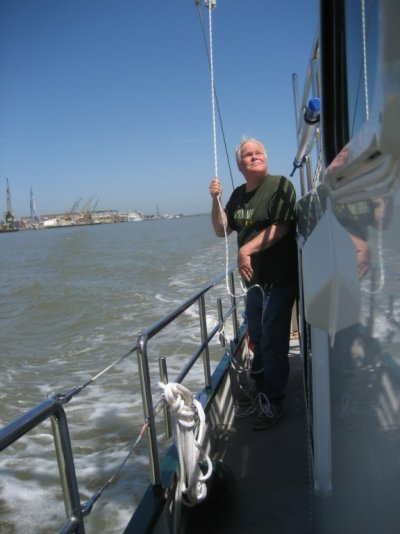Nomad Willy
Guru
This post from BoatDesign.net is very recent and sums up a lot of the mysteries of underloading damage or potential damage. It dos'nt address the whole issue from where we stand as operators of old trawler yachts but will tend to enlighten all that read it.*
<table class="tborder" style="background-color:#d1d1e1;color:#000066;width:100%;border-width:1px;border-color:#0b198c;border-style:solid;" border="0" cellspacing="1" cellpadding="6" align="center"><tbody><tr><td class="alt1" style="font:normal normal normal 10pt/normal verdana, geneva, lucida, 'lucida grande', arial, helvetica, sans-serif;background-color:#e4e4e4;color:#000066;">From a diesel generator technical manual
"Diesel engines can suffer damage as a result of misapplication or misuse - namely internal glazing and carbon buildup. This is a common problem in generator sets caused by failure to follow application and operating guidelines - ideally diesel engines should run at least around 60-75% of their maximum rated load. Short periods of low load running are permissible providing the set is brought up to full load, or close to full load on a regular basis.
Internal glazing and carbon buildup is due to prolonged periods of running at low speeds and/or low loads. Such conditions may occur when an engine is left idling as a 'standby' generating unit, ready to run up when needed, (misuse); if the engine powering the set is over-powered (misapplication) for the load applied to it, causing the diesel unit to be under-loaded, or as is very often the case, when sets are started and run off load as a test (misuse).
Running an engine under low loads causes low cylinder pressures and consequent poor piston ring sealing since this relies on the gas pressure to force them against the oil film on the bores to form the seal. Low cylinder pressures causes poor combustion and resultant low combustion pressures and temperatures.
This poor combustion leads to soot formation and unburnt fuel residues which clogs and gums piston rings. This causes a further drop in sealing efficiency and exacerbates the initial low pressure. Glazing occurs when hot combustion gases blow past the now poorly sealing piston rings, causing the lubricating oil on the cylinder walls to 'flash burn', creating an enamel-like glaze, which smooths the bore and removes the effect of the intricate pattern of honing marks machined into the bore surface. which are there to hold oil and return it to the crankcase via the scraper ring.
Hard carbon also forms from poor combustion and this is highly abrasive and scrapes the honing marks on the bores leading to bore polishing, which then leads to increased oil consumption (blue smoking) and yet further loss of pressure, since the oil film trapped in the honing marks is intended to maintain the piston seal and pressures. Un-burnt fuel leaks past the piston rings and contaminates the lubricating oil. Poor combustion causes the injectors to become clogged with soot, causing further deterioration in combustion and black smoking.
The problem is increased further the formation of acids in the engine oil caused by condensed water and combustion by-products which would normally boil off at higher temperatures. This acidic build-up in the lubricating oil causes slow but ultimately damaging wear to bearing surfaces.
This cycle of degradation means that the engine soon becomes irreversibly damaged and may not start at all and will no longer be able to reach full power when required. Under loaded running inevitably causes not only white smoke from unburnt fuel but over time is joined by the blue smoke of burnt lubricating oil leaking past the damaged piston rings, and the black smoke caused by the damaged injectors. This pollution is unacceptable to the authorities and any neighbours.
Once glazing or carbon build up has occurred, it can only be cured by stripping down the engine and re-boring the cylinder bores, machining new honing marks and stripping, cleaning and de-coking combustion chambers, fuel injector nozzles and valves. If detected in the early stages, running an engine at maximum load to raise the internal pressures and temperatures, allows the piston rings to scrape glaze off the bores and allow carbon buildup to be burnt off. However, if glazing has progressed to the stage where the piston rings have seized into their grooves this will not have any effect.
The situation can be prevented by carefully selecting the generator set in accordance with manufacturers printed guidelines.
For emergency only sets, which are islanded, the emergency load is often only about 1/4 of the sets standby rating, this apparent over size being necessitated to be able to meet starting loads and minimizing starting voltage drop. Hence, the available load is not usually enough for load testing and again engine damage will result if this is used as the weekly or monthly load test. This situation can be dealt with by hiring in a load bank for regular testing, or installing a permanent load bank. Both these options cost money in terms of engine wear and fuel use but are better than the alternative of under loading the engine.
</td></tr></tbody></table>
<table class="tborder" style="background-color:#d1d1e1;color:#000066;width:100%;border-width:1px;border-color:#0b198c;border-style:solid;" border="0" cellspacing="1" cellpadding="6" align="center"><tbody><tr><td class="alt1" style="font:normal normal normal 10pt/normal verdana, geneva, lucida, 'lucida grande', arial, helvetica, sans-serif;background-color:#e4e4e4;color:#000066;">From a diesel generator technical manual
"Diesel engines can suffer damage as a result of misapplication or misuse - namely internal glazing and carbon buildup. This is a common problem in generator sets caused by failure to follow application and operating guidelines - ideally diesel engines should run at least around 60-75% of their maximum rated load. Short periods of low load running are permissible providing the set is brought up to full load, or close to full load on a regular basis.
Internal glazing and carbon buildup is due to prolonged periods of running at low speeds and/or low loads. Such conditions may occur when an engine is left idling as a 'standby' generating unit, ready to run up when needed, (misuse); if the engine powering the set is over-powered (misapplication) for the load applied to it, causing the diesel unit to be under-loaded, or as is very often the case, when sets are started and run off load as a test (misuse).
Running an engine under low loads causes low cylinder pressures and consequent poor piston ring sealing since this relies on the gas pressure to force them against the oil film on the bores to form the seal. Low cylinder pressures causes poor combustion and resultant low combustion pressures and temperatures.
This poor combustion leads to soot formation and unburnt fuel residues which clogs and gums piston rings. This causes a further drop in sealing efficiency and exacerbates the initial low pressure. Glazing occurs when hot combustion gases blow past the now poorly sealing piston rings, causing the lubricating oil on the cylinder walls to 'flash burn', creating an enamel-like glaze, which smooths the bore and removes the effect of the intricate pattern of honing marks machined into the bore surface. which are there to hold oil and return it to the crankcase via the scraper ring.
Hard carbon also forms from poor combustion and this is highly abrasive and scrapes the honing marks on the bores leading to bore polishing, which then leads to increased oil consumption (blue smoking) and yet further loss of pressure, since the oil film trapped in the honing marks is intended to maintain the piston seal and pressures. Un-burnt fuel leaks past the piston rings and contaminates the lubricating oil. Poor combustion causes the injectors to become clogged with soot, causing further deterioration in combustion and black smoking.
The problem is increased further the formation of acids in the engine oil caused by condensed water and combustion by-products which would normally boil off at higher temperatures. This acidic build-up in the lubricating oil causes slow but ultimately damaging wear to bearing surfaces.
This cycle of degradation means that the engine soon becomes irreversibly damaged and may not start at all and will no longer be able to reach full power when required. Under loaded running inevitably causes not only white smoke from unburnt fuel but over time is joined by the blue smoke of burnt lubricating oil leaking past the damaged piston rings, and the black smoke caused by the damaged injectors. This pollution is unacceptable to the authorities and any neighbours.
Once glazing or carbon build up has occurred, it can only be cured by stripping down the engine and re-boring the cylinder bores, machining new honing marks and stripping, cleaning and de-coking combustion chambers, fuel injector nozzles and valves. If detected in the early stages, running an engine at maximum load to raise the internal pressures and temperatures, allows the piston rings to scrape glaze off the bores and allow carbon buildup to be burnt off. However, if glazing has progressed to the stage where the piston rings have seized into their grooves this will not have any effect.
The situation can be prevented by carefully selecting the generator set in accordance with manufacturers printed guidelines.
For emergency only sets, which are islanded, the emergency load is often only about 1/4 of the sets standby rating, this apparent over size being necessitated to be able to meet starting loads and minimizing starting voltage drop. Hence, the available load is not usually enough for load testing and again engine damage will result if this is used as the weekly or monthly load test. This situation can be dealt with by hiring in a load bank for regular testing, or installing a permanent load bank. Both these options cost money in terms of engine wear and fuel use but are better than the alternative of under loading the engine.
</td></tr></tbody></table>



